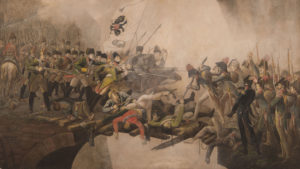
Suvorov: An offensive goes awry in the high mountains
The diplomatic starting point is surprisingly complex and requires explanation: A Russian general coming from Italy, with the support of Austria, enters into battle against France in what is now Switzerland.
The year is 1799. War is raging in Europe, with Austria and Russia forming an alliance against France. It is a struggle for influence, power, territory – and for the notion of the ideal social order. On the one hand, you have the existing order of an estates society in which a person’s social origin determines his or her rights and obligations. On the other hand, you have France’s new notion that everyone should have the same rights and obligations.
In these European wars, the Coalition Wars, Switzerland is occupied by France and later partially, though not completely, liberated by Austrian and Russian troops. This is where the Russian general comes in, who will leave an unparalleled legacy in Switzerland. General Alexander Vasilyevich Suvorov, highly decorated and undefeated, is instructed to liberate the territory of present-day Switzerland with the help of Austria. He approaches from northern Italy and ventures boldly across the Alps in order to surprise the enemy. But the French troops under General Massena have a plan of their own: As Suvorov’s troops are struggling to cross the Alps, they defeat the Russian troops who are already in Switzerland at the Second Battle of Zurich. Now General Suvorov has no one to join forces with for the big attack against the French. The planned surprise attack turns into an exhausting retreat with many casualties.

Fighting at the Devil’s Bridge ca. 1800, artist unknown, paper. Photo: Swiss National Museum
After a 300-kilometre-long march, and scaling a height of 10,000 metres in 21 days, the Russian soldiers reach Chur and depart from what is now Switzerland at Maienfeld. Of the 21,000 who set off, 15,000 remain, 5,000 of them badly wounded. The mountain artillery has been abandoned bit by bit, and half the animals are missing. French troops at Sargans observe the retreat of the Russian army.
Contemporaries compare the general’s journey over the Gotthard, Kinzig Pass, Pragel Pass, Panix and over the St. Luzisteig with Hannibal’s, and it is seen more as a battle against the elements and less as a failed campaign.
What is a tragedy with countless deaths for the soldiers is tantamount to a plague for the local population. 20,000 soldiers are looking for food, a bed, warmth, fodder for thousands of pack animals, and they take what they can get. In the remote villages and valleys that is not much, but it is all the locals have. Their supplies are gone even before the onset of winter, their cattle stolen or slaughtered. It is many weeks before the dead lying in the fields and on the mountainsides are buried; it takes decades for villages and their residents to recover from the occupation and military campaigns.
Switzerland has a long way to go before it finds peace. The debate regarding social and state structure has only just begun with the French invasion. Numerous fierce conflicts, revolts and the last civil war determine the political climate leading up to the founding of the federal state in 1848, which would lay the cornerstone for Switzerland as we know it today.

Russian and French soldiers fighting over the Swiss cow. Story of a Swiss Cow, David Hess, 1801, reproduction. Original: ZBZ Department of Prints and Drawings Ms. K 2a, BII. 138-144
General Suvorov. Great Powers in the High Mountains
Forum Schweizer Geschichte Schwyz
14.1. - 30.9.2018
The exhibition traces Suvorov’s arduous journey across the Alps, describes the tremendous ordeals the Russian troops faced, and tells of the incredible hardships the local mountain population suffered. In addition, the exhibition puts the campaign into the historical context of the French Revolution, the Coalition Wars, and the fate of the Helvetic Republic.



